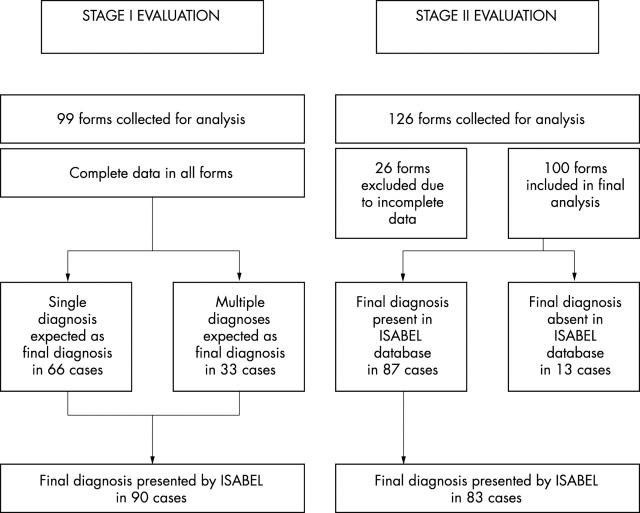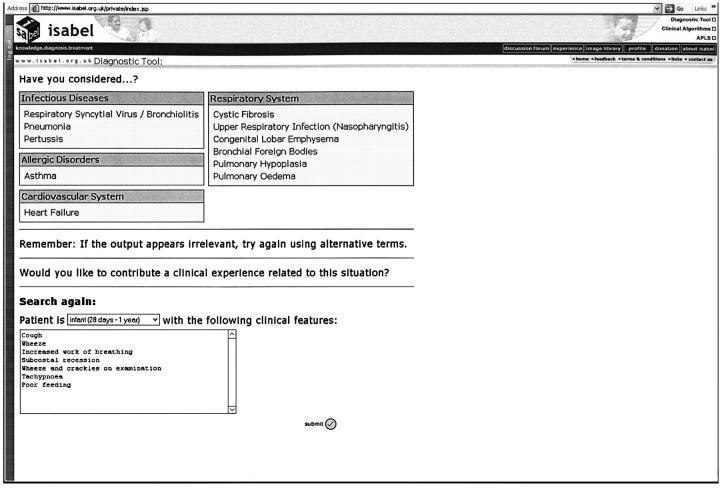Abstract
Aims: To test the clinical accuracy of a web based differential diagnostic tool (ISABEL) for a set of case histories collected during a two stage evaluation.
Methods: Setting: acute paediatric units in two teaching and two district general hospitals in the southeast of England. Materials: sets of summary clinical features from both stages, and the diagnoses expected for these features from stage I (hypothetical cases provided by participating clinicians in August 2000) and final diagnoses for cases in stage II (children presenting to participating acute paediatric units between October and December 2000). Main outcome measure: presence of the expected or final diagnosis in the ISABEL output list.
Results: A total of 99 hypothetical cases from stage I and 100 real life cases from stage II were included in the study. Cases from stage II covered a range of paediatric specialties (n = 14) and final diagnoses (n = 55). ISABEL displayed the diagnosis expected by the clinician in 90/99 hypothetical cases (91%). In stage II evaluation, ISABEL displayed the final diagnosis in 83/87 real cases (95%).
Conclusion: ISABEL showed acceptable clinical accuracy in producing the final diagnosis for a variety of real as well as hypothetical case scenarios.
Full Text
The Full Text of this article is available as a PDF (223.5 KB).
Figure 1.
Outcome of all cases collected for both stages of evaluation.
Figure 2.
Sample screen from ISABEL: input of clinical features.
Figure 3.
Sample screen from ISABEL: output of diagnostic reminders classified by system.
Selected References
These references are in PubMed. This may not be the complete list of references from this article.
- Alberti K. G. Medical errors: a common problem. BMJ. 2001 Mar 3;322(7285):501–502. doi: 10.1136/bmj.322.7285.501. [DOI] [PMC free article] [PubMed] [Google Scholar]
- Bankowitz R. A., McNeil M. A., Challinor S. M., Parker R. C., Kapoor W. N., Miller R. A. A computer-assisted medical diagnostic consultation service. Implementation and prospective evaluation of a prototype. Ann Intern Med. 1989 May 15;110(10):824–832. doi: 10.7326/0003-4819-110-10-824. [DOI] [PubMed] [Google Scholar]
- Berner E. S., Webster G. D., Shugerman A. A., Jackson J. R., Algina J., Baker A. L., Ball E. V., Cobbs C. G., Dennis V. W., Frenkel E. P. Performance of four computer-based diagnostic systems. N Engl J Med. 1994 Jun 23;330(25):1792–1796. doi: 10.1056/NEJM199406233302506. [DOI] [PubMed] [Google Scholar]
- Brassey J., Elwyn G., Price C., Kinnersley P. Just in time information for clinicians: a questionnaire evaluation of the ATTRACT project. BMJ. 2001 Mar 3;322(7285):529–530. doi: 10.1136/bmj.322.7285.529. [DOI] [PMC free article] [PubMed] [Google Scholar]
- Ely J. W., Osheroff J. A., Ebell M. H., Bergus G. R., Levy B. T., Chambliss M. L., Evans E. R. Analysis of questions asked by family doctors regarding patient care. BMJ. 1999 Aug 7;319(7206):358–361. doi: 10.1136/bmj.319.7206.358. [DOI] [PMC free article] [PubMed] [Google Scholar]
- Godlee F., Smith R., Goldmann D. Clinical evidence. BMJ. 1999 Jun 12;318(7198):1570–1571. doi: 10.1136/bmj.318.7198.1570. [DOI] [PMC free article] [PubMed] [Google Scholar]
- Gorman P. N., Ash J., Wykoff L. Can primary care physicians' questions be answered using the medical journal literature? Bull Med Libr Assoc. 1994 Apr;82(2):140–146. [PMC free article] [PubMed] [Google Scholar]
- Hersh W. R., Hickam D. H. How well do physicians use electronic information retrieval systems? A framework for investigation and systematic review. JAMA. 1998 Oct 21;280(15):1347–1352. doi: 10.1001/jama.280.15.1347. [DOI] [PubMed] [Google Scholar]
- Hunt D. L., Haynes R. B., Hanna S. E., Smith K. Effects of computer-based clinical decision support systems on physician performance and patient outcomes: a systematic review. JAMA. 1998 Oct 21;280(15):1339–1346. doi: 10.1001/jama.280.15.1339. [DOI] [PubMed] [Google Scholar]
- Neale G., Woloshynowych M., Vincent C. Exploring the causes of adverse events in NHS hospital practice. J R Soc Med. 2001 Jul;94(7):322–330. doi: 10.1177/014107680109400702. [DOI] [PMC free article] [PubMed] [Google Scholar]
- Ramnarayan P., Britto J. Paediatric clinical decision support systems. Arch Dis Child. 2002 Nov;87(5):361–362. doi: 10.1136/adc.87.5.361. [DOI] [PMC free article] [PubMed] [Google Scholar]
- Sadegh-Zadeh K. Fundamentals of clinical methodology. 4. Diagnosis. Artif Intell Med. 2000 Nov;20(3):227–241. doi: 10.1016/s0933-3657(00)00066-x. [DOI] [PubMed] [Google Scholar]
- Swender P. T., Tunnessen W. W., Jr, Oski F. A. Computer-assisted diagnosis. Am J Dis Child. 1974 Jun;127(6):859–861. doi: 10.1001/archpedi.1974.02110250085012. [DOI] [PubMed] [Google Scholar]
- Wyer P. C., Rowe B. H., Guyatt G. H., Cordell W. H. Evidence-based emergency medicine. The clinician and the medical literature: when can we take a shortcut? Ann Emerg Med. 2000 Aug;36(2):149–155. doi: 10.1067/mem.2000.108656. [DOI] [PubMed] [Google Scholar]
- de Dombal F. T., Leaper D. J., Staniland J. R., McCann A. P., Horrocks J. C. Computer-aided diagnosis of acute abdominal pain. Br Med J. 1972 Apr 1;2(5804):9–13. doi: 10.1136/bmj.2.5804.9. [DOI] [PMC free article] [PubMed] [Google Scholar]





